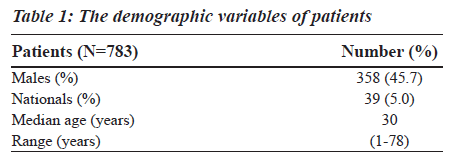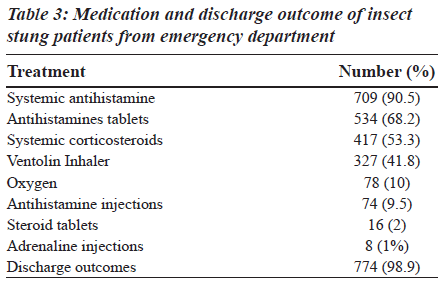ISSN: 0970-938X (Print) | 0976-1683 (Electronic)
Biomedical Research
An International Journal of Medical Sciences
- Biomedical Research (2009) Volume 20, Issue 3
Characteristics, Severity and Management of Insect-stung Patients
1Department of Internal Medicine, Faculty of Medicine, UAE University, UAE
2Department Community Medicine, Faculty of Medicine, UAE University, UAE
3Department of Medicine, Jimi Hospital
4Department of Medical Statistics & Epidemiology, Hamad Medical Corporation, and Weill Cornell Medical College, Qatar
- *Corresponding Author:
- Dr. Shirina Alsowaidi
Department of Internal Medicine
Faculty of Medicine
UAE University, UAE
E-mail: Shirina.alsowaidi@uaeu.ac.ae
Accepted date: May 20 2009
We aim to assess the demographic, clinical manifestation and management of insect-stung patients. About 783 (46% male; 95% expatriate workers) records of Al-Ain hospital patients were analyzed. According to Muller classification, class I severity was common in the youngest age group. Majority (56.9%) of the subjects had class III severity. Multi-variate analysis confirmed that significantly less severe cases were present in the youngest age group (0-10 years) only (P less than 0.0005) and in male patients (P less than 0.0005). Anti-histamine and corticosteroids, but not epinephrine, were commonly administered. Where data was available (32.6%), the site of the sting was mostly on legs (16.6%). Insect stings were incompletely reported, often with severe symptoms (class III), and under-treated. The severity of allergic reactions was associated with older age and female gender. Emphasis on training of healthcare providers could potentially improve the current level of diagnosis and management.
Keywords
Antihistamine, allergic, characteristics, insect stings
Introduction
Allergic reactions resulting from insect stings, predominantly hymenoptera, are one of the most common causes of anaphylaxis worldwide [1,2]. In the United Arab Emirates (UAE), limited information is available with regard to patient characteristics, risk factors, and current management guiltiness.
In general, the causes of allergic reactions include insect stings, food allergens, and other environmental risk factors. Moreover, the severity of allergic reactions is often related to older age, gender and ethnicity. Although allergic reactions may vary in magnitude, the consequences of under-diagnosed and under-treated allergic reactions may lead to life-threatening anaphylaxis [3]. Thus, appropriate prevention strategies, diagnosis, and often aggressive treatment approaches are necessary. Currently, the treatment of choice in the emergency unit includes parenteral epinephrine, cardiovascular stabilization, systemic antihistamines and corticosteroids as well as inhaled agonist.
In the UAE, among other factors, intensive plantation projects, over the past two decades or so, have helped increase the number of insects in wild areas as well as recreational areas. This has led to an increase in incidence of morbidity from insect stings and subsequent allergic reactions. In this study, we aim to investigate the demographic characteristics, clinical manifestation, and management of allergy reactions due to common insect stings among emergency department patients in Al-Ain hospital, UAE.
Aim
To assess the demographic characteristics, clinical manifestation and management of allergy reactions due to common insect sting among emergency department patients in Al-Ain hospital, United Arab Emirates (UAE).
Materials and Methods
In this retrospective observational study, we analyzed a total of 783 records of insect stung patients who visited the emergency department (ED) of Al-Ain hospital, in the period between February 1993 to September 1995. Demographic data, clinical manifestation and treatment regimens were collected and analyzed.
Statistical analysis
Statistical Package for Social Sciences (SPSS) version 15.0 software for Windows was used. Cross tabulation was used to present the descriptive values of the combined population. Cross tabulation was used to present the distribution of severity by age group.
We assessed the independent relationship of age (5 categories) and sex with severity (0=class 1-2; 1=class 3-4) by means of logistic regression. A P-value < 0.05 will be considered statistically significant.
Results
Table 1 shows the demographic data of the patients. The overwhelming majority of patients were none UAE nationals (95%) of heterogeneous expatriate workers, 46% of subjects were male. More than 50% of all subjects were children and young adults.
Cross tabulation of age and severity of reaction, according to Muller classification, are shown in Table 2. Unlike class I severity found in the youngest age group, majority of the population (56.9%) suffered from allergic reaction of class III severity. Multivariate Logistic regression analysis confirmed that significantly less severe cases were present in the youngest age group (0-10 years) only (P less than 0.0005) and in male patients (less than 0.0005).
With regard to treatment, anti-histamine and corticosteroids, but not epinephrine, were administered to most of the patients and regardless of severity (Table 3).
The site of the sting was mostly on legs (16.6%), arms (8.9%), head (2.7%), trunk (2.7%), and the neck (1.5%). Nevertheless, majority of the patients (67.4%) had no available data with regard to the site of sting.
Discussion
The overwhelming majority of cases seen at the emergency department was young people and may possibly represent the general population. Consistent with the literature, allergic reactions due to insect stings are seemingly more severe among adults as compared to children and among males as compared to females in this population [6-8]. The less severe findings among children may indicate appropriate parental awareness to early treatment even with mild symptoms. Occupational exposure, particularly among adult males, could not be explained by the current data. Contrary to current practice, epinephrine was not commonly used as a favorable first line emergency treatment for allergic reactions possibly due to under diagnosis. However, cardiovascular stabilization, systemic antihistamines and corticosteroids as well as inhaled volterin seem to have been adequately administered on regular basis.
A study reported in the United States[6-8] showed that although guidelines suggest specific approaches for the emergency management of insect sting allergy, concordance with these guidelines appears low in patients with a severe insect sting reaction.
Conclusion
Insect-stung patients who visited the emergency unit of Al-Ain hospital were, mostly, incompletely reported, often with severe symptoms (class III), and under treated. The severity of the allergic reactions was associated with older age and male gender. Emphasis on training of healthcare providers could potentially improve the current level of diagnosis and management.
Acknowledgment
The authors would like to thank the staff of Al-Ain Hospital emergency unit for their generous help during the collection of this data.
References
- Neugut AI, Ghtak AT, Miller RL. Anaphylaxis in the United States: an investigation into its epidemiology. Arch Intern Med 2001;161:15–21.
- Peng MM, Jick H. A population-based study of the incidence, cause, and severity of anaphylaxis in the United Kingdom. Arch Intern Med 2004;164:317–9.
- Yocum MW, Butterfield JH, Klein JC, Volcheck GW, Schroeder DR, Silverstein MD. Epidemiology of anaphylaxis in Olmsted county: A population-based study. J Allergy Clin Immunol 1999;104:452–6.
- Mueller HL. Insect allergy. Pediatr Clin North Am 1959;6:917–52.
- Pérez Pimiento AJ, Prieto Lastra L, Rodríguez Cabreros MI, Vásquez Bautista AA, García Cubero A, Calvo Manuel E. Systemic reactions to wasp sting: Is the clinical pattern related to age, sex and atopy? Allergol Immunopathol (Madr) 2007;35:10-4.
- Clark S, Long AA, Gaeta TJ, Camargo CA Jr. Multicenter study of emergency department visits for insect sting allergies. J Allergy Clin Immunol 2005;116:643-9.
- Clark S, Camargo CA Jr. Emergency treatment and prevention of insect-sting anaphylaxis. Curr Opin Allergy Clin Immunol 2006;6:279-83. Review.
- Clark S, Gaeta TJ, Kamarthi GS, Camargo CA. ICD-9-CM coding of emergency department visits for food and insect sting allergy. Ann Epidemiol 2006;16:696-700.


